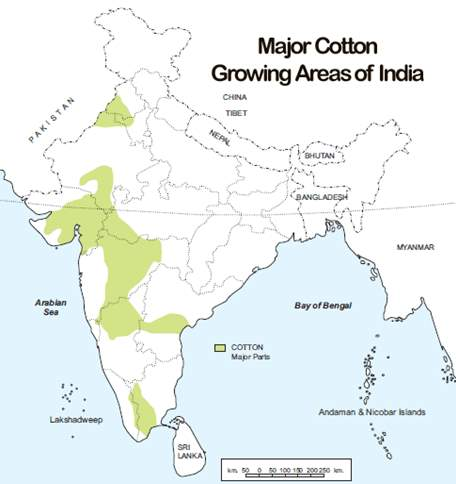Demand for Reduction of Import Duty on Cotton | 01 Dec 2021
Why in News
Recently, the Tamil Nadu Chief Minister has requested the Union Textiles Minister to direct the concerned ministries to remove import duty levied on cotton.
- The textile industry is the second largest employment provider in the state and Tamil Nadu accounts for 1/3rd size of the textile business of the country.
Key Points
- Major Demands:
- Removal of the 11% Import duty levied on cotton imports. Also Yarn manufacturers may be given priority over traders in cotton procurement.
- Extension of 5% interest subvention to spinning mills for cotton procurement during the peak season (December-March).
- Reducing the minimum lot size of e-auction of cotton to 500 bales, which is sustainable for the Micro, Small and Medium-sized Enterprises (MSMEs), has also been urged.
- Reasons for the Demand:
- The demand is because of the grave situation of cotton and yarn price volatility and its impact on the prices of fabrics and garments.
- The present crisis has led to mass cancellation of export orders and hardships in fulfilling long term export commitments.
- One of the major reasons for the cotton price volatility is due to the imposition of 5% Basic Customs Duty (BCD), 5% Agriculture Infrastructure Development Cess (AIDC) and 10% Social Welfare Cess in the Budget 2021-22 which amounts to an overall import duty of 11%.
- The demand is because of the grave situation of cotton and yarn price volatility and its impact on the prices of fabrics and garments.
- Concerns related to the Import Duty:
- The import duty on raw cotton would erode the competitiveness of the value-added segments that have a business size of around Rs 50,000 crores in exports and Rs 25,000 crores in the domestic market.
- These segments provide jobs to around 12 lakh people.
- The import duty on raw cotton would erode the competitiveness of the value-added segments that have a business size of around Rs 50,000 crores in exports and Rs 25,000 crores in the domestic market.
Cotton
- About:
- Kharif Crop which requires 6 to 8 months to mature.
- Drought – resistant crop ideal for arid climates.
- Occupies 2.1% of the world’s arable land, meets 27% of the world’s textiles needs.
- Temperature: Between 21-30°C.
- Rainfall: Around 50-100cm.
- Soil Type: Well-drained black cotton soil (Regur Soil) (E.g. Soil of Deccan Plateau)
- Products: fibre, oil and animal feed.
- Top Cotton Producing Countries: India > China > USA
- Top Cotton Producing States in India: Gujarat > Maharashtra > Telangana > Andhra Pradesh > Rajasthan.
- Four cultivated species of cotton: Gossypium arboreum, G.herbaceum, G.hirsutum and G.barbadense.
- Gossypium arboreum and G.herbaceum are known as old-world cotton or Asiatic cotton.
- G.hirsutum is also known as American cotton or upland cotton and G.barbadense as Egyptian cotton. These are both new world cotton species.
- Hybrid Cotton: Cotton made by crossing two parent strains that have different genetic characters. Hybrids are often spontaneously and randomly created in nature when open-pollinated plants naturally cross-pollinate with other related varieties.
- Bt Cotton: It is a genetically modified organism or genetically modified pest-resistant variety of cotton.
- Cotton in India:
- Cotton is an important fibre and cash crop which plays a dominant role in the industrial and agricultural economy of India.
- India is the largest producer of cotton in the world and the third largest exporter. It is also the largest consumer of cotton in the world.
- The pest-resistant Genetically Modified (GM) Bt cotton hybrids have captured the Indian market (covering over 95% of the area under cotton) since their introduction in 2002.
- India produces about 6 million tons of cotton every year which is about 23% of the world's cotton.
- India produces about 51% of the total organic cotton production of the world.

